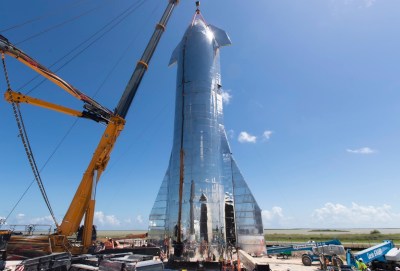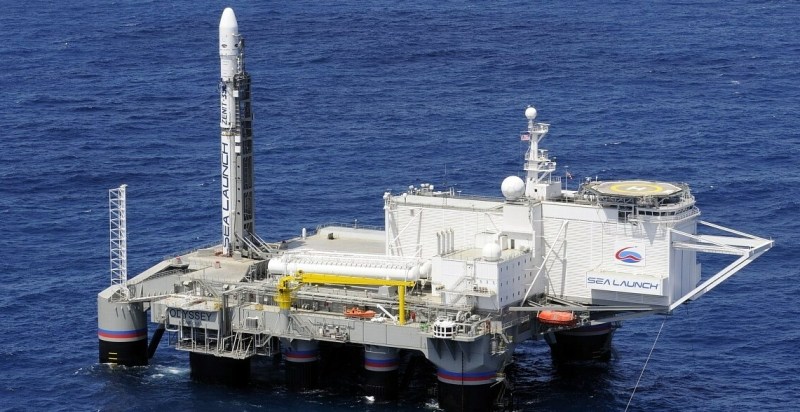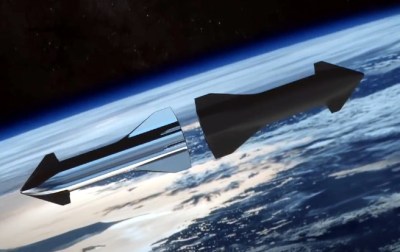While early prototypes for SpaceX’s Starship have been exploding fairly regularly at the company’s Texas test facility, the overall program has been moving forward at a terrific pace. The towering spacecraft, which CEO Elon Musk believes will be the key to building a sustainable human colony on Mars, has gone from CGI rendering to flight hardware in just a few short years. That’s fast even by conventional rocket terms, but then, there’s little about Starship that anyone would dare call conventional.

Nearly every component of the deep space vehicle is either a technological leap forward or a deviation from the norm. Its revolutionary full-flow staged combustion engines, the first of their kind to ever fly, are so complex that the rest of the aerospace industry gave up trying to build them decades ago. To support rapid reusability, Starship’s sleek fuselage abandons finicky carbon fiber for much hardier (and heavier) stainless steel; a material that hasn’t been used to build a rocket since the dawn of the Space Age.
Then there’s the sheer size of it: when Starship is mounted atop its matching Super Heavy booster, it will be taller and heavier than both the iconic Saturn V and NASA’s upcoming Space Launch System. At liftoff the booster’s 31 Raptor engines will produce an incredible 16,000,000 pounds of thrust, unleashing a fearsome pressure wave on the ground that would literally be fatal for anyone who got too close.
Which leads to an interesting question: where could you safely launch (and land) such a massive rocket? Even under ideal circumstances you would need to keep people several kilometers away from the pad, but what if the worst should happen? It’s one thing if a single-engine prototype goes up in flames, but should a fully fueled Starship stack explode on the pad, the resulting fireball would have the equivalent energy of several kilotons of TNT.
Thanks to the stream of consciousness that Elon often unloads on Twitter, we might have our answer. While responding to a comment about past efforts to launch orbital rockets from the ocean, he casually mentioned that Starship would likely operate from floating spaceports once it started flying regularly:
While history cautions us against looking too deeply into Elon’s social media comments, the potential advantages to launching Starship from the ocean are a bit too much to dismiss out of hand. Especially since it’s a proven technology: the Zenit rocket he references made more than 30 successful orbital launches from its unique floating pad.
Last of the Soviet Rockets
Developed in the 1980s, the Zenit rocket was intended to replace the aging Soyuz and Proton launchers that were the backbone of the Soviet space program. Similar in size and specifications to the early versions of SpaceX’s Falcon 9, the liquid oxygen and refined kerosene powered Zenit would be cheaper and safer to operate than its predecessors. Its ability to act as a strap-on booster for larger vehicles, another similarity shared with the Falcon 9, also promised to further streamline space logistics for the USSR.
Of course, that never happened. Before all the bugs could be worked out of the new booster the Soviet Union collapsed, and the program became mired in politics. Not only did the Russian Federation lack the funds to simultaneously operate the Soyuz, Proton, and Zenit to their full potential, but there was concern about launching sensitive payloads on a rocket that was now being manufactured in the newly independent Ukraine. After several high profile failures in the 1990s, the Zenit program was very nearly cancelled entirely.
One if By Land, Two if By Sea
While the dissolution of the Soviet Union ultimately kept the Zenit from replacing the Soyuz and Proton, it also provided some tantalizing businesses possibilities. With the Cold War officially over, an international coalition of companies from the United States, Russia, Ukraine, and Norway was formed to offer Zenit to commercial customers. Rather than having to decide which nation would serve as the rocket’s permanent home base, a modified version of the vehicle would fly from a self-propelled oceangoing launch pad that started life as an offshore oil rig. This revolutionary new service was called, aptly enough, Sea Launch.

Beyond the political aspect of not being tied to any one nation, launching from the ocean offered a number of compelling advantages. For one, it was much safer should the rocket explode on the pad or fail shortly after liftoff. This was especially important given the somewhat spotty track record of the Zenit. It would also allow launches from near the Earth’s equator, which imparts greater tangential velocity on the vehicle during ascent and directly translates into increased payload capacity.
The initial boost provided by the Earth’s rotation can be approximated by taking the planet’s rotational speed at the equator and multiplying it by the cosine of the launch site’s latitude:
While the gains offered by equatorial sea launch might seem small compared to orbital velocity (roughly 28,000 km/h), the rocket equation is exceptionally unforgiving. Even a tiny reduction in the acceleration required to reach orbit allows more of the vehicle’s mass to be devoted to payload instead of propellant. Additionally, it means that payloads destined for equatorial orbits, such as geosynchronous communication satellites, don’t need to adjust their inclination after separation from the booster. This further reduces propellant requirements and gets the satellite into its final operational orbit faster, which results in a longer useful lifetime.
An Experiment Cut Short
In total 36 Zenit rockets were launched from Sea Launch’s floating pad between 1999 and 2014, 32 of which successfully delivered their payloads to orbit. The most serious failure was in January 2007, when the rocket carrying the NSS-8 satellite failed a few seconds after ignition and engulfed the launchpad in a fireball.
Due to the design of the floating launchpad, the faltering rocket fell through an opening in the platform and sunk; causing only superficial damage to the infrastructure aboard. As part of normal operating procedure, no personnel were aboard the Ocean Odyssey platform at the time of the launch, so no injuries were sustained. The platform was repaired and ready for its next launch just six months after the incident.
From a technical standpoint, Sea Launch showed there was definite promise for ocean-launched orbital rockets. The handful of failures experienced by the program were in no way related to the logistics of transporting the rocket to the equator or the unique nature of the floating launchpad. Nor was the single failure aboard Ocean Odyssey enough to delay the program for very long, much less stop it entirely. If anything, the NSS-8 explosion demonstrated the inherent safety of ocean launches in the event of a catastrophic failure.
Unfortunately, Sea Launch was eventually killed by the same thing that made it possible in the first place: political turmoil. The 2014 annexation of Crimea by Russia strained the country’s relationship with Ukraine, and while publicly Sea Launch denied the situation had any impact on their operation, within a few months the staff were laid off and the Ocean Odyssey and its support ship were mothballed.
Rockets On the High Seas
SpaceX has already gained considerable experience landing their rockets on floating platforms, which arguably, is a harder feat than lifting off from one. The Sea Launch project proved beyond a shadow of a doubt the concept worked, it just needs to be scaled up. As Elon pointed out, Starship and the Super Heavy booster are a far larger vehicle than Zenit, but that doesn’t mean the core technology would need to be any different.

The overall Starship architecture is built around the concept of orbital refueling, which means each mission will actually consist of multiple launches in quick succession. Up to five or six in the case of a trip to Mars, all launched within a few days of each other.
Equatorial sea launches would help streamline this process as much as possible, allowing the maximum amount of propellant to be delivered to the Starship waiting in orbit in the least amount of time. The per-flight gains won’t be much, but SpaceX is clearly playing the long game. At the very least, it would help keep the incredible amount of noise such an operation would produce as far away from civilization as possible.
Or, as we’ve learned with SpaceX in the past, it might never happen. Perhaps the cost of building a fleet of gargantuan floating spaceports will end up being so high as to negate any advantages gained from ocean launches. With all the changes the Starship design has undergone in just a few short years, very little about this futuristic craft can be said with absolute certainty. Many doubted it would ever even get this far.
But even if SpaceX doesn’t go forward with launching Starship from the ocean, there’s still hope for the concept of ocean-going rocketry. The Russian space agency Roscosmos has announced they plan on getting the languishing Ocean Odyssey up and running again, this time using only domestic technology. Just like stainless steel rockets, it seems that ocean launchpads are coming back in style for the New Space Race.




















Where on the Equator was(is?) Sea Launch located?
Wikipedia says 154 degrees West.
We didn’t stop flying stainless steel rockets until the last Atlas III launch in 2005, and the stainless Centaur upper stage is still going strong.
…and the Atlas family is based on a 1960s ICBM. That’s sort of the point. Nobody has tried to design a brand new first stage booster out of stainless for decades. Not since lighter materials have been available.
It’s a mistake to say aluminum alloys are “lighter” than stainless. Atlas and Centaur both have world-class mass fractions, often beating equivalent aluminum stages. They do it by operating under constant pressure so the whole tank structure is basically under a pure tensile load at all times. Stainless has just as good of mass-specific tensile strength as an aluminum alloy (sometimes higher, depending on processing conditions) and this approach can often be lighter. It’s also stronger at both high and low temperatures compared to carbon fiber composites once appropriate knock-down factors are included.
About the rocket motors, In additon to this…
Some time (years?) ago I saw a video about the computer modelling of the combustion process inside the rocket engine, with automatic resolution scaling with very high resolution on the flamefront (almost to molecular level) and much coarser resolution in less interesting area’s.
It used those big cubes which are split in 8 smaller cubes for volumetric modelling. No doubt there is a name for it, but I can’t recall just now. The video is worth watching though.
octree
The video in question is probably the “GPUs to Mars” presentation from GTC 2015.
https://on-demand-gtc.gputechconf.com/gtcnew/sessionview.php?sessionName=s5398-gpus+to+mars%3A+full-scale+simulation+of+spacex%27s+mars+rocket+engine is the link to the presentation on the conference website, which has a PDF of the slides but it looks like the video link is busted? Gave a strange error message for me.
https://www.youtube.com/watch?v=vYA0f6R5KAI gets you to the talk
Seems to be a continuation of the approach of treating the ocean is a big garbage can.
If the force of the Superheavy booster launch is enough to kill people close to the site – what effect will it have on marine environment? Exert that force on a not-very compressible medium (water), how far will it travel? What will it squish?
Dynamite fishing for whales?
https://what-if.xkcd.com/156/
Not to mention all the chemicals they’ll be dripping off into the sea. Toxic hypergolic fuels, hydraulic fluids…
Super Heavy is powered by oxygen and methane, so it’s nothing the sea isn’t used to. Not to mention they’d be venting into the air instead of dripping as liquids.
The rocket engines are ignited with a hypergolic fuel mixture, which effectively sprays right down into the ocean waters as the engines start.
Wrong again. Raptor engine uses electric ignition instead of TEA-TEB. It was deemed to hinder both reusability and testability.
I don’t know whether you are troll or just uninformed dude spewing anti-SpaceX propaganda knowing nothing.(Perhaps just because you don’t like their chief engineer who can be regarded as an arshole.)
SpaceX does NOT use hypergolic fuels on Falcon 9 boosters. They use hypergolics only in Dragon capsule.
Moreover both Starship and its booster won’t use hypergolics and won’t even use kerosine.
Spaceships and its booster run on OXYGEN and METHANE which is more or less cow farts!
The product of clean burn is WATER although there won’t be clean burn by design. Engines are usually run just slightly fuel or oxygen rich in order to lower the temperatures.
For anybody interested in rocket polution (not only of Starship): https://www.youtube.com/watch?v=C4VHfmiwuv4
So they’re leaking water into the ocean?! They’ll raise sea levels!
I’ve forgotten to mention the CO2 but in long term this can be solved a must be solved for Mars. There are many methods from which one of the oldest is Sabatier reaction which is more than century old and together with water electrolysis produce O2 and CH4 from CO2 and water.
It is as green as its power supply and it is absurdly uneconomical right now. But this is not specific to rocketry. In my home country (Slovakia) and in the country I’ve been living for a decade (Czech republic) there are methane buses galore. Basically the rule is: if it doesn’t have overhead electrical collectors (https://en.wikipedia.org/wiki/Trolleybus) then there is huge chance it has ICE engine running on CH4 though there’s been some experiments with battery buses.
>SpaceX does NOT use hypergolic fuels on Falcon 9 boosters
The Falcon 9 boosters carry a mixture of TEA-TEB to ignite and re-ignite the engines. Technically these are classified as pyrophoric substances, but in combination with the liquid oxygen it forms a hypergolic mix.
The fact that it is pyrophoric also means that it will burn completely eventually (i.e. if not immediately then in the next second…). Which of those resulting aluminium and boron oxides are toxic in your mind?
Moreover Raptor engines use electric ignition for reusability and testability and Mars reasons like not having to synthesize, handle it, fill it to the rocket when electric spark can do the job with a little more engineering.
The pressure would just bounce off the surface. Plus it’s not like anything is preventing the creatures from just swimming away.
Source for information? Physical reasoning?
When something bounces off a surface it exerts a force on that surface (action and re-action in Newtonian terms).
So what happens to the pressure/force on the ocean surface? It doesn’t just disappear – where does it go?
What effect does that have on the micro and macro flora/fauna in the ocean.
Time is what might prevent creatures swimming away. If somebody was standing next to this thing when it launched,
how will they have the time to walk away? Speed of sound in the medium is far faster than most things move.
(Even assuming they knew to move.)
Might as well say the people caught in the explosion of that fertilizer in Beiruit could have run away.
At the speed of sound, the surface of the water will essentially be a solid surface. You might as well ask who current launches effect any moles which might have tunnels under the pad.
The sound of the rocket exhaust hitting the water causes a sound wave to propagate form the point outwards under the water, and it’s probably loud enough to kill anyways, like dynamite fishing.
The sound will probably deafen whales and dolphins etc. who happen to pass within a few dozen miles of the launchpad.
The very different speed of sound results in a very poor impedance match. Which is a good thing here, most of the energy is reflected. That’s the reason, the dynamite, if (mis)used for fishing needs to be placed under water, not above to be effective.
Moreover there is a simple technology for underwater noise elimination and it is usually deployed around construction sites like when building offshore wind farms, static oil-rings and so on.
http://www.trianel-borkum.de/en/umwelt/noise-prevention-bubble-curtain/
But the “Dude” above (I couldn’t reply to him directly because of max depth of tree of replies had been reached) in his ignorance or SpaceX hatred must spew bullshit.
Stop all progress, somebody might injure a tradigrad!
tradigrad?
Traditional graduate?
We have too many college graduates (as well as students) that easily butthurt right now!
B^)
This is a super ironic comment as Starship will be fully reusable while every other current orbital rocket (besides Falcon 9) is fully expendable, literally dumping used stages directly into the ocean (or villages or the steppe). So unlike almost all other rockets today, Starship will NOT be treating the ocean as a big garbage can. (and as others have said, it will be using entirely non-toxic fuels that leave no residue, unlike most rockets today)
(Your comment is what passes for dialogue on social media, though, where uninformed and unreasonable but inflammatory comments get the most traction and support from the algorithm.)
Sound does not transmit well at all between air into the water due to the orders of magnitude difference in density (think: massive impedance mismatch). The sound will almost entirely bounce right off the surface and into the air where it can dissipate. So marine life will be essentially unharmed by the sound (unlike, say, Sea Dragon that was to launch from underwater and thus would’ve needed active measures like a bubble fence to keep out sea life and shield them from the acoustic energy).
Another very helpful aspect of launching from equator is that the launch windows for rendezvous in equatorial orbit open every hour or so, instead of every day at best for other (inclined) orbits.
Ahhh Elon
95% Genius
5% Arsehole
100% Inspirational :-)
The die is cast. All future floating spaceports must bear silly names from The Culture.
Please post names here for possible consideration.
But, I suspect, like sports fields in the USA, they will be named after commercial sponsors.
e.g. “The Verizon on the Horizon!”
Some apt names are mentioned in “The State of the Art”.
“Dramatic Exit”
“Funny, it Worked Last Time”
“Only Slightly Bent”
All the pics and illustrations for this post are reminiscent of the recent Chris Evans gaffe
And future versions may have a sharp claw on each to prevent the rocket from skidding off the platform when landing.
They will be called VelocoRaptors.
So burning methane and oxygen gives you (I quote: WATER)?
Perhaps you want to repeat your elementary chemistry classes. Just sayin’.
CH4+O2 = CO2 +H20